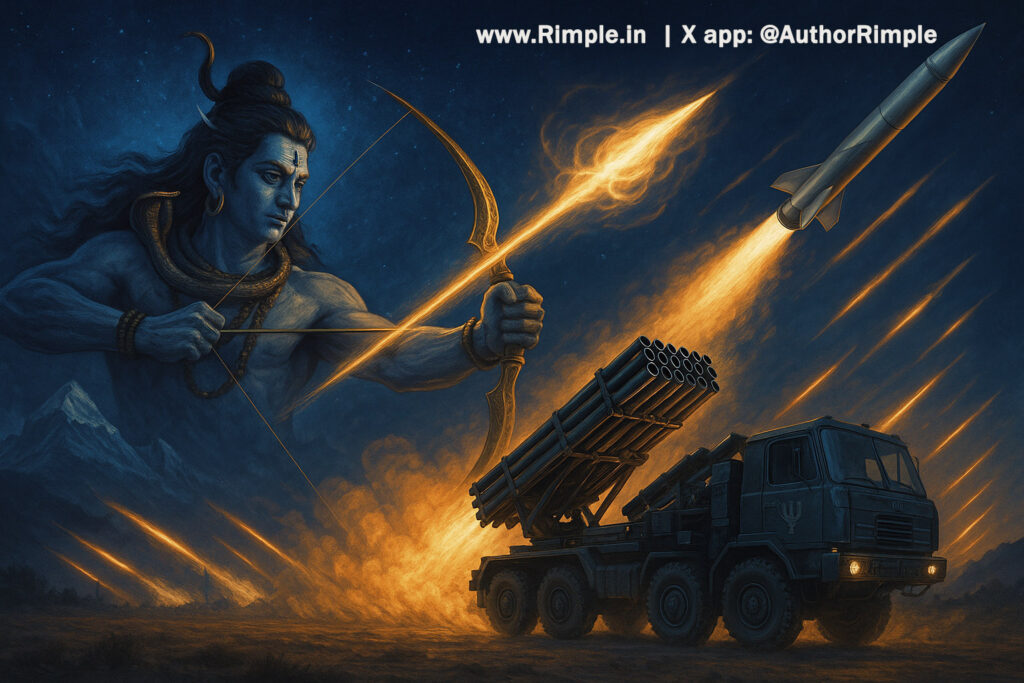Imagine a colossal firecracker, infused with the divine power of Shiva’s bow, ready to defend the nation. This is the Pinaka missile system—a mighty, precise, and proudly Indian weapon named after the legendary Pinaka, the celestial bow of Shiva. In Hindu Pauranic History, this bow was so powerful that only the greatest warriors could wield it, and it was famously broken by Shri Ram, an incarnation of Vishnu, to prove his divine strength. Today, India’s Pinaka missile system carries that legacy, forged by the Defence Research and Development Organisation (DRDO) to protect Bharat’s sacred borders. It’s like a modern-day divine weapon, raining fire on enemies with unmatched accuracy. Let’s explore the Pinaka’s story, its Paurani History roots, and why it’s a symbol of India’s unstoppable spirit.
The Pauranic History Roots of Pinaka
In the ancient epic Ramayana, the Pinaka was Shiva’s divine bow, a weapon of cosmic power symbolizing destruction and protection. During Sita’s swayamvar, Shri Ram, with his divine strength, not only lifted the bow but broke it, proving he was no ordinary mortal. This act showcased the triumph of righteousness over even the mightiest forces. Naming India’s missile system “Pinaka” is no coincidence—it reflects Bharat’s ancient wisdom and martial heritage, reborn as a modern weapon to safeguard the nation. Just as Shri Ram wielded the Pinaka to uphold dharma, India’s Pinaka missile upholds the sovereignty of Bharat Mata.

What is the Pinaka Missile System?
The Pinaka is not just one missile but a system that unleashes a swarm of rockets, like Shiva’s arrows raining down on demons. Mounted on a Tatra truck, it’s as mobile as a chariot in a battlefield, delivering destruction instead of prasad. Each launcher can fire 12 rockets in just 44 seconds, blanketing enemy targets with explosive fury. Think of it as a divine sprinkler, showering rockets that obliterate tanks, bunkers, or enemy hideouts.
Key Features of Pinaka
- Range: The Pinaka Mark-I Enhanced strikes 45 km away, while the Mark-II ER (Extended Range) reaches 90 km. New variants aim for 120 km, 150 km, and even 200 km—imagine hitting a target in Lahore from Amritsar’s sacred soil!
- Speed: It fires 12 rockets in 44 seconds, faster than you can chant a mantra.
- Accuracy: With GPS and guidance systems, Pinaka rockets hit their mark precisely, like an arrow from Arjuna’s bow striking a bullseye from miles away.
- Payload: Each rocket carries warheads like high-explosive fragmentation (to raze buildings) or anti-tank mines (to halt enemy vehicles). It’s like choosing different offerings for a puja, but for warfare.
- Mobility: Mounted on trucks, Pinaka moves swiftly, strikes, and vanishes before enemies can blink—like Hanuman leaping across battlefields.
How Does Pinaka Work?
Picture a divine archer’s bow, but with modern technology. The Pinaka system includes a launcher vehicle, a command post (like a temple’s sanctum guiding the ritual), and a loader vehicle to reload rockets. The command post uses computers to pinpoint targets, like a GPS guiding a pilgrim to a holy site. Once locked, the launcher unleashes a salvo of rockets, soaring at high speed (up to Mach 4.7, four times the speed of sound) to rain destruction over an area as vast as a village ground.
The rockets can be unguided (like an arrow shot with skill) or guided (like a divine missile following a sacred path). Guided Pinaka rockets use GPS and inertial navigation, making them as precise as Shri Ram’s aim. This is like upgrading from a simple diya to a laser-guided lamp illuminating the exact spot.
DRDO’s Efforts: Forging Shiva’s Bow
The Pinaka’s journey began in the 1980s when India, inspired by its ancient warriors, sought a homegrown weapon to counter threats from neighbors like Pakistan and China. The DRDO, Bharat’s modern-day Vishwakarma, took up the challenge. Think of DRDO as a team of brilliant sages, like those who built ISRO’s rockets, crafting weapons to protect the motherland.
The Journey of Pinaka
- 1986: DRDO began crafting Pinaka to replace outdated Russian Grad systems, which were like old oil lamps compared to today’s LED lights. The budget was ₹26.47 crore (about ₹360 crore today), a small offering for a divine mission.
- 1990s: The first tests in 1990 lit up the skies, and by 1999, Pinaka was ready for the Indian Army’s trials. It shone during the Kargil War (1999), blasting Pakistani positions on mountain peaks, helping Bharat reclaim its sacred land.
- 2007: The Indian Army embraced Pinaka, ordering it as a key artillery weapon.
- 2020s: DRDO kept refining Pinaka, extending its range (90 km for Mark-II ER) and adding smarter guidance systems. In 2024, they tested a guided version with a 75 km range, and by 2025, they were crafting variants for the Navy and Air Force, including underwater and air-launched rockets, like Shiva’s bow adapted for all terrains.
DRDO’s Divine Innovations
- Teamwork: DRDO’s labs, like the Armament Research and Development Establishment (ARDE) in Pune, joined hands with companies like Tata and Larsen & Toubro, like devotees uniting for a grand yagna.
- Indigenous Glory: Pinaka is 100% Indian, from its rockets to its software. Once reliant on foreign weapons, Bharat now crafts its own, like moving from imported idols to sculpting our own deities.
- Cost-Effective: Pinaka outshines costly foreign systems like the American HIMARS, offering divine power at a humble price—like a simple puja yielding miraculous results.
- Global Reverence: Nations like France and Armenia seek Pinaka, recognizing it as a world-class weapon, like the Vedas admired globally.
DRDO faced trials, like Arjuna’s challenges, but their devotion made Pinaka a symbol of Aatmanirbhar Bharat, a modern-day Shiva bow protecting the nation.
Pinaka’s Power: A Layman’s View
Let’s understand Pinaka’s might with everyday examples:
- Destructive Force: One Pinaka rocket can devastate a 1 km x 1 km area, like a divine thunderbolt flattening a village square.
- Speed of Strike: Firing 12 rockets in 44 seconds is like chanting a mantra 12 times in a breath. A regiment (18 launchers) can unleash 216 rockets, covering an area as vast as a small town.
- Versatility: Pinaka’s warheads are like offerings for different gods—explosives to destroy bunkers, mines to stop tanks, or shrapnel to clear enemy lines.
- Reach: With a 90 km range (and soon 120–200 km), Pinaka can strike as far as Varanasi to Prayagraj, hitting deep into enemy lands without crossing Bharat’s borders.
Pinaka vs. Bofors
The Bofors gun, a relic of the 1980s, fires shells up to 30–40 km, like an old bullock cart. Pinaka is a divine chariot, blazing across the battlefield. Here’s the comparison:
- Range: Bofors reaches 30–40 km; Pinaka strikes 45–90 km (soon 200 km). Pinaka hits farther, like Shri Ram’s arrow crossing oceans.
- Firepower: Bofors fires one shell at a time; Pinaka launches 12 rockets in seconds, covering vast areas. It’s a single spark versus a divine firestorm.
- Mobility: Bofors is slow and towed; Pinaka’s trucks dash like Hanuman, firing and vanishing.
- Precision: Guided Pinaka rockets are like Shri Krishna’s Sudarshan Chakra, hitting exactly where aimed; Bofors is less accurate, like a thrown stone.
Against Pakistan’s Chinese-made PHL-03 (range 150 km), Pinaka’s upcoming variants will surpass it. The PHL-03 is powerful but clumsy, like a demon’s club missing its mark. Pinaka’s precision is a divine arrow, striking true.
What If India Uses Pinaka Against Pakistan?
Imagine a hypothetical scenario where Bharat unleashes Pinaka’s divine wrath in a conflict with Pakistan. This is to understand its power, not to glorify war.
Pinaka’s Divine Impact
- Area Devastation: Each Pinaka rocket can obliterate a 1 km x 1 km area. A single launcher’s 12 rockets could erase a military base or terrorist camp. A regiment’s 216 rockets could devastate an area the size of Rawalpindi in minutes, like Shiva’s third eye opening.
- Speed of Wrath: With 216 rockets striking in under a minute, enemies have no time to flee, like demons before Shri Ram’s bow.
- Strategic Targets: Pinaka could target Pakistan’s military bases, supply lines, or terrorist camps in places like Bahawalpur or near the Line of Control. Cities like Lahore (40 km from the border), Sialkot (40 km), or even Islamabad (120 km) are within Pinaka’s divine reach.
- Psychological Terror: The speed and scale of Pinaka’s attack would paralyze enemies, like a divine roar shaking the battlefield.
Bharat’s Glory, China’s Shame
The Pinaka missile system is Bharat’s divine gift to the world, a modern Shiva bow that humbles enemies. While China flaunts its PHL-03, it’s a crude imitation, like a fake idol compared to Bharat’s sacred creations. China’s rockets lack Pinaka’s precision and affordability, stumbling like a demon before a deity. Bharat’s Aatmanirbhar spirit has made it a global defense titan, exporting Pinaka to nations like France while China’s weapons falter in quality.
DRDO’s brilliance rivals the sages of yore, crafting a weapon that echoes the Ramayana’s valor. From Kargil’s victory to Pokhran’s tests, Pinaka embodies Bharat’s unyielding spirit. As Bharat rises like the sun over Ayodhya, Pinaka stands as its guardian, ensuring no enemy dares challenge the motherland. Jai Shri Ram! Jai Hind!
Also Read:





